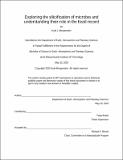| dc.contributor.advisor | Tanja Bosak. | en_US |
| dc.contributor.author | Morgenstein, Kyle J.(Kyle Jarad) | en_US |
| dc.contributor.other | Massachusetts Institute of Technology. Department of Earth, Atmospheric, and Planetary Sciences. | en_US |
| dc.date.accessioned | 2020-09-03T17:49:23Z | |
| dc.date.available | 2020-09-03T17:49:23Z | |
| dc.date.copyright | 2020 | en_US |
| dc.date.issued | 2020 | en_US |
| dc.identifier.uri | https://hdl.handle.net/1721.1/127146 | |
| dc.description | Thesis: S.B., Massachusetts Institute of Technology, Department of Earth, Atmospheric, and Planetary Sciences, May, 2020 | en_US |
| dc.description | Cataloged from the official PDF of thesis. | en_US |
| dc.description | Includes bibliographical references (pages [24]-[29]). | en_US |
| dc.description.abstract | Filamentous cyanobacteria that built macroscopic tufted mats in Proterozoic peritidal environments were fossilized by silicification, but the environmental and biological factors that shaped these structures and enabled this type of preservation are not well understood. Recent work has shown that coccoidal cyanobacteria can become fossilized because they can sequester silica from seawater that is undersaturated with respect to silica. Here, we use taphonomy experiments to demonstrate that filamentous cyanobacteria that form tufted and conical mats are also able to mediate the precipitation of silica in seawater that is undersaturated with respect to silica as well. These results show that different marine cyanobacteria and their macroscopic structures have a high potential to be preserved by silicification. We find that the exterior of macroscopic structures such as tufts and pillars are preferentially silicified, and more completely silicified at silica concentrations below saturation in seawater. The interior of these structures may be preserved by later diagenetic minerals. These results are consistent with microfossil assemblages found in early diagenetic chert deposits throughout the Proterozoic. The data suggest abundant Ca-rich sulfated polysaccharides in the exopolymeric substance (EPS), which are likely the site of silicification. Interactions among similar organisms, seawater chemistry, and silica in evaporative environments may account for the two-billion-year long record of exceptionally silicified filamentous and coccoidal cyanobacteria and their macroscopic aggregates in peritidal environments. | en_US |
| dc.description.statementofresponsibility | by Kyle J. Morgenstein. | en_US |
| dc.format.extent | 29 unnumbered pages | en_US |
| dc.language.iso | eng | en_US |
| dc.publisher | Massachusetts Institute of Technology | en_US |
| dc.rights | MIT theses may be protected by copyright. Please reuse MIT thesis content according to the MIT Libraries Permissions Policy, which is available through the URL provided. | en_US |
| dc.rights.uri | http://dspace.mit.edu/handle/1721.1/7582 | en_US |
| dc.subject | Earth, Atmospheric, and Planetary Sciences. | en_US |
| dc.title | Exploring the silicification of microbes and understanding their role in the fossil record | en_US |
| dc.type | Thesis | en_US |
| dc.description.degree | S.B. | en_US |
| dc.contributor.department | Massachusetts Institute of Technology. Department of Earth, Atmospheric, and Planetary Sciences | en_US |
| dc.identifier.oclc | 1191838996 | en_US |
| dc.description.collection | S.B. Massachusetts Institute of Technology, Department of Earth, Atmospheric, and Planetary Sciences | en_US |
| dspace.imported | 2020-09-03T17:49:22Z | en_US |
| mit.thesis.degree | Bachelor | en_US |
| mit.thesis.department | EAPS | en_US |
